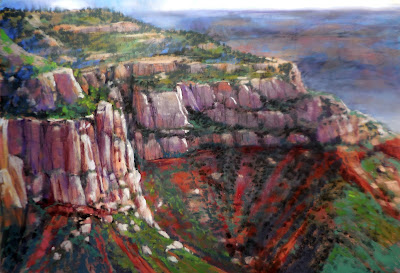It's been quite a sensory contrast going from one beautiful scenic location to another. Each place is unique and breath-taking, making it hard to imagine that anything can top it - until we go to the next spot and are struck with awe and wonder all over again.
Grand Canyon North Rim
The North Rim was spectacular with red and rust colored walls in the foreground, accented by endless background layers shadowed in purple and blue, stretching all the way to the horizon. Doug's first painting was bought on site by a man from Seattle. He painted two more, one of which Sue has claimed to hang in the dining room at home. Sue's hikes around the rim were the best so far and she can't imagine any place better, so that must mean that more great hikes are yet to come!
It was tough to leave the Grand Canyon, but we heard the Sequoias' beckoning call. We left morning temperatures in the mid 60's and embarked on a grueling eleven hour journey through the hottest desert areas in the state, including a pass by Death Valley. Temperatures were well into the 100's all day, with the highest being 113. On a few hills, we had to turn off the air conditioner to keep the engine from overheating. The car radiated heat like we were driving through a furnace. We were overjoyed to reach our campsite near Sequoia as it was higher elevation and cooler.
Sequoia National Park
The majesty of the giant Sequoias is difficult to articulate. They are one of the oldest living species on earth and grow at high altitude on the west side of the Sierra Nevada Mountains, only in specific environments. As you stand and look up at them, you are surrounded by silence, along with a feeling of spaciousness much like being inside a cathedral.
Rangers told us that they can't really determine the Sequoia's life span. Trees seem only to die when they fall over due to soil erosion or other causes. The oldest tree is called General Sherman, estimated to be 3,500 years old and possibly the oldest tree on earth. It's top was sheared off by lightning years ago, but the remainder of the tree continues to grow.
Biologists have determined that Sequoias require forest fires to reproduce. Their cones are small and tightly closed with seeds the size of oat flakes. Fire heats and opens the cones to release the seeds. Meanwhile, their bark is up to two feet thick, resistant to fire and has strong healing properties.
Many trees have char marks from fire and you can see this in Doug's paintings. His favorite is a close up of the base of the trees, called Among Giants.
Next we are off to Yosemite National Park for two weeks and Doug will be teaching a workshop.
If you'd like to see all Doug's paintings so far, click this link to his website:











Spectacular vistas at Grand Canyon... Beautiful.
ReplyDeleteAbsolutely spectacular!
ReplyDeletetom lebish